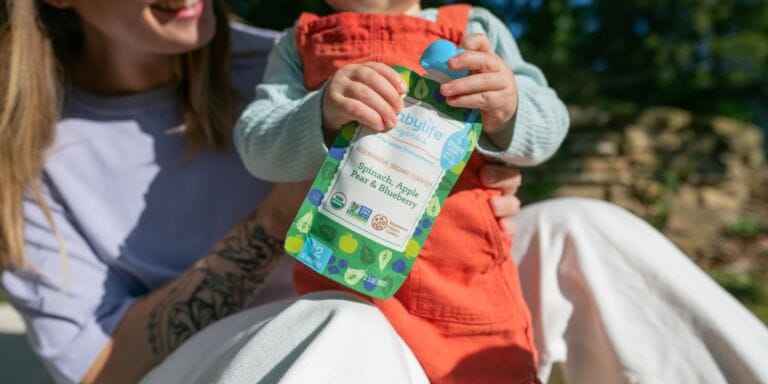14 science-backed ways to help prevent SIDS in babies

While there's a lot we don't know about SIDS, there are certain steps to take for SIDS prevention in many cases.
Table of Contents
- What is SIDS exactly?
- When are babies most at risk for SIDS?
- How common is SIDS?
- What can parents do to prevent SIDS?
- 12 more steps parents can take that have been proven to help reduce the risk of SIDS
- 1. Put your baby to sleep on a firm, flat surface
- 2. Keep your baby out of your bed for the first year
- 3. Keep blankets, pillows and stuffed toys out of the sleep space
- 4. Keep your baby in your room for the first 6 months of life
- 5. Put your baby to sleep with a pacifier
- 6. Safely swaddle for all nights and naps
- 7. Consider a smart sleeper
- 8. Breastfeed if you're able to
- 9. Quit smoking & maintain a smoke-free home
- 10. Don't let your baby get too hot… or too cold
- 11. Practice tummy time during the day
- 12. Keep your baby up to date with immunizations
Infant death isn’t a topic that’s easy to talk about. SIDS, or sudden infant death syndrome, is a terrible and mysterious condition that is responsible for thousands of infant deaths per year in the United States. And what makes SIDS feel especially frightening for parents is that it seems to strike without warning.
But the good news is that with attention to some precautions and safe sleep guidelines, you can reduce SIDS risk significantly. It’s my hope that understanding the facts about SIDS can empower parents, ease some of their fears and help them create the safest sleep environment for their little ones. Let’s unpack how to prevent SIDS.
What is SIDS exactly?
SIDS is the unexplained death of a seemingly healthy infant under 1 year of age, typically occurring while the child is sleeping. The babies just stop breathing, but nobody knows why for sure. Some researchers have linked brain abnormalities and brain chemistry abnormalities to SIDS. Another study identified a gene mutation that could play a role in SIDS, while yet another identified a potential biomarker that could signal which infants may be more susceptible to SIDS.
But ultimately, the cause of SIDS seems to be due to a number of complex, intertwined factors, both genetic and environmental.
Sometimes the acronym SIDS is used interchangeably with another term: sudden unexpected infant death (SUID). SUID includes not just unexplained deaths, but also those caused by suffocation and strangulation.
Related: New research highlights a potential reason why some babies die of SIDS
When are babies most at risk for SIDS?
Babies are at risk for SIDS between 1 month and 1 year of age, but 90% of SIDS cases occur before the 6-month mark.
How common is SIDS?
SIDS is the cause of death for about 1,500 babies per year in the U.S. according to the most recent data from the CDC (Centers for Disease Control and Prevention). SUID or sudden unexpected infant death, a category which includes deaths from SIDS, suffocation and unknown causes, is the cause of death for about 3,700 babies per year in the United States, using 2022 data. SIDS is the leading cause of death for children between 1 month and 1 year of age.
Related: Breastfeeding for 2 months can cut SIDS risk in half
SIDS is significantly less common in the United States than it was 30 years ago. In the 1980s, SIDS tragically claimed the lives of 5,000 babies a year. At that time, parents were told never to put a baby to sleep on their back, because doctors worried back-sleeping babies might choke on their spit-up. In the early 1990s, research proved that stomach sleeping actually quadrupled the risk of SIDS, and the famous Back to Sleep initiative—now called Safe to Sleep—was born, raising public awareness of the importance of sleep safety to lower the risk of SIDS.
Thanks to the efforts of doctors recommending back sleeping for babies and parents following safe sleep guidelines for their babies, SIDS deaths dropped almost 50% in the 1990s—a huge win. Sadly, that progress has stalled out over the past two decades, and suffocation and strangulation deaths have hardly been reduced at all.
What can parents do to prevent SIDS?
While there’s a lot we don’t know about the causes of many SIDS deaths, there are certain risk factors associated with infant sleep death that are within some human control.
We know that the two biggest triggers of SUID are sleeping on the stomach and sleeping in an unsafe location.
The 2 most important steps parents can take to reduce SIDS risk are:
1. Put your baby to sleep on their back for every sleep, not their side or stomach.
2. Give your baby a safe sleeping environment.
The back is the only safe sleeping position for babies. Sleeping on the stomach raises the risk of SIDS by three to four times. When babies struggle to fall asleep on their backs, move around or roll over onto their stomachs, frustrated and tired parents may try things that aren’t safe, like putting padded bedding into the bassinet or crib, using an infant sleep positioner, co-sleeping without safety precautions or sleeping with the baby on the couch.
12 more steps parents can take that have been proven to help reduce the risk of SIDS
1. Put your baby to sleep on a firm, flat surface
Inclined sleepers, swings, baby nests and car seats are not safe for sleep. Babies’ heads are very heavy—and in a sitting position, those heavy heads inevitably droop toward the chest. As a result, the doubling over of the neck or sliding into the sleeper’s restraining belt could cut off airflow.
Sadly, inclined sleepers have been linked to numerous deaths. Similarly, those cozy-looking baby nests and even nursing pillows pose a suffocation risk. If a baby turns their face or partially rolls into one of these plush supports, their thin neck might not be strong enough to lift up their heavy head and place it out of danger. Once face down, it can be difficult for a baby to breathe.
2. Keep your baby out of your bed for the first year
Bed-sharing can be a wonderful way to bond with your little one…after your child celebrates their first birthday. A large study found that 64% of deaths among babies under 2 months happened in a parent’s bed. Until your tot blows out that big first birthday candle, it’s best that they sleep in their own space.
3. Keep blankets, pillows and stuffed toys out of the sleep space
Blankets, pillows, bumpers and stuffed toys could cover the face causing suffocation. So, for the first year of life, the bassinet and crib is a no-fly-zone for these soft goods.
Related: When can your baby sleep with a blanket? Experts say it’s older than you think
4. Keep your baby in your room for the first 6 months of life
Studies show that sharing a room during the first six months of life reduces SIDS risk. Having your love-bug close makes it more likely that you’ll hear and be able to quickly respond to your baby’s needs.
Related: How to tell when your baby should sleep in their own room, according to a sleep expert
5. Put your baby to sleep with a pacifier
If you’re wondering: Do pacifiers prevent SIDS? We’ve got good news: Giving a baby a pacifier when they go to bed has been associated with more than a 50% reduction in SIDS… even if it falls out after 20 minutes. Doctors haven’t quite cracked the code as to why sucking works such magic, but because research consistently points to the positive link between SIDS reduction and pacifier use, the AAP recommends pacifiers be part of every baby’s sleeping routine—for both naps and nighttime.
6. Safely swaddle for all nights and naps
Snug swaddling helps calm crying by imitating the snug sensation of the womb that babies love so much, making it less likely that a tired parent will feel the need to bring the baby into bed. Swaddling also makes it harder for your baby to roll to their stomach (and nighttime rolling boosts a baby’s SIDS risk by eight to 45 times). However, it’s important that you stop swaddling or free their arms as soon as your baby shows signs of rolling over, usually around 4 months old.
Related: 6 easy-to-use swaddles that babies and parents love
7. Consider a smart sleeper
SNOO Smart Sleeper was born out of my deep desire to reduce SUID. In the past 20 years, more American babies have died from SUID than the number of combatants killed in the entire Vietnam War—that’s a tragedy. Not only does SNOO secure babies on the back (and has received FDA approval for this purpose), but it imitates the womb with snug swaddling, gentle motion and white noise that helps babies sleep longer. Improving a parent’s sleep helps them make smarter decisions and better judgments. And this lessens the temptation parents may have to use an unsafe sleeping surface or bring the baby into bed (one-third of moms have reported accidentally falling asleep with the baby with them in bed or on a sofa, which puts the baby at risk).
Related: Dr. Harvey Karp shares how to wean from SNOO in 3 simple steps
8. Breastfeed if you’re able to
A 2017 study found that breastfeeding for at least two months—even if supplemented with formula—can slice SIDS risk nearly in half.
9. Quit smoking & maintain a smoke-free home
Both smoking during pregnancy and second-hand smoke have been linked to SIDS.
10. Don’t let your baby get too hot… or too cold
Overheating and overcooling put babies at risk for SIDS. So, it’s best to channel Goldilocks here and keep the room’s temperature just right (between 68°F and 72°F). Avoid hats and resist the urge to overdress your baby. You’ll know you’ve hit the sweet spot if your baby’s ears feel slightly warm (neither too hot nor too cold).
11. Practice tummy time during the day
Little bits of baby exercise known as tummy time helps your little one develop the strong muscles they’ll need to lift their head and move away from choking and suffocation risks.
12. Keep your baby up to date with immunizations
Respiratory illness raises the risk of SIDS. Keeping your infant on a regular vaccine schedule can help reduce the incidence or severity of preventable childhood diseases.
Using these steps to reduce SIDS risk will help your baby stay safer… and help you sleep better.
A version of this story was originally published on October 7, 2020. It has been updated.


































